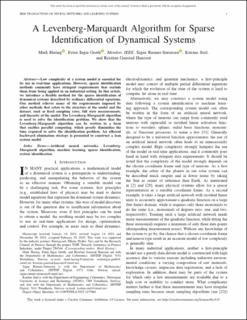| dc.contributor.author | Haring, Mark A. M. | |
| dc.contributor.author | Grøtli, Esten Ingar | |
| dc.contributor.author | Riemer-Sørensen, Signe | |
| dc.contributor.author | Seel, Katrine | |
| dc.contributor.author | Hanssen, Kristian Gaustad | |
| dc.date.accessioned | 2023-03-01T16:57:17Z | |
| dc.date.available | 2023-03-01T16:57:17Z | |
| dc.date.created | 2022-11-29T12:03:04Z | |
| dc.date.issued | 2022 | |
| dc.identifier.citation | IEEE Transactions on Neural Networks and Learning Systems. 2022. | en_US |
| dc.identifier.issn | 2162-237X | |
| dc.identifier.uri | https://hdl.handle.net/11250/3055133 | |
| dc.description.abstract | Low complexity of a system model is essential for its use in real-time applications. However, sparse identification methods commonly have stringent requirements that exclude them from being applied in an industrial setting. In this article, we introduce a flexible method for the sparse identification of dynamical systems described by ordinary differential equations. Our method relieves many of the requirements imposed by other methods that relate to the structure of the model and the dataset, such as fixed sampling rates, full state measurements, and linearity of the model. The Levenberg-Marquardt algorithm is used to solve the identification problem. We show that the Levenberg-Marquardt algorithm can be written in a form that enables parallel computing, which greatly diminishes the time required to solve the identification problem. An efficient backward elimination strategy is presented to construct a lean system model. | en_US |
| dc.language.iso | eng | en_US |
| dc.publisher | IEEE | en_US |
| dc.rights | Navngivelse 4.0 Internasjonal | * |
| dc.rights.uri | http://creativecommons.org/licenses/by/4.0/deed.no | * |
| dc.title | A Levenberg-Marquardt Algorithm for Sparse Identification of Dynamical Systems | en_US |
| dc.title.alternative | A Levenberg-Marquardt Algorithm for Sparse Identification of Dynamical Systems | en_US |
| dc.type | Peer reviewed | en_US |
| dc.type | Journal article | en_US |
| dc.description.version | publishedVersion | en_US |
| dc.rights.holder | © 2022 The authors. | en_US |
| dc.source.journal | IEEE Transactions on Neural Networks and Learning Systems | en_US |
| dc.identifier.doi | 10.1109/TNNLS.2022.3157963 | |
| dc.identifier.cristin | 2083855 | |
| dc.relation.project | Norges forskningsråd: 294544 | en_US |
| cristin.ispublished | true | |
| cristin.fulltext | postprint | |
| cristin.qualitycode | 2 | |

